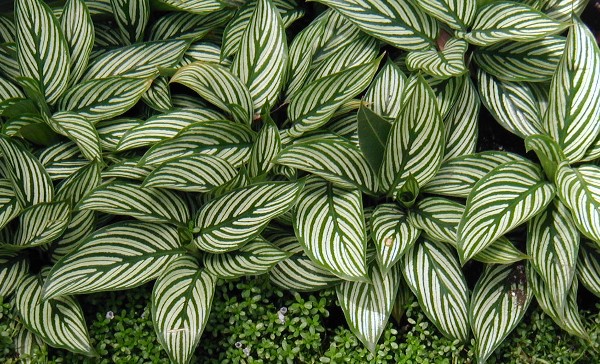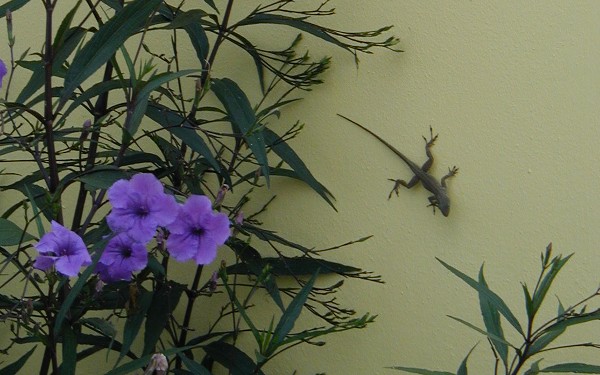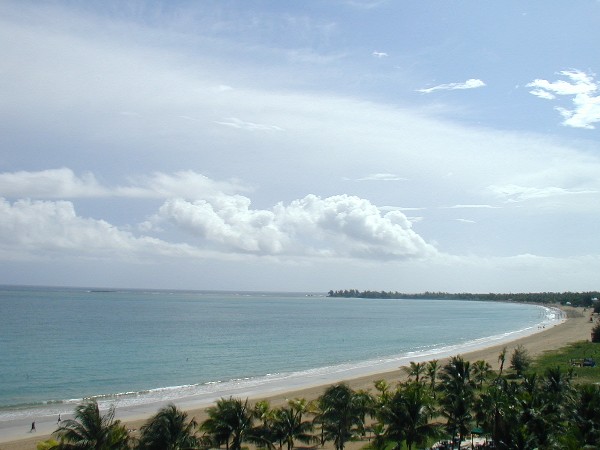
"Why don't you come for a visit?" said Paul. He's been working in Puerto Rico since sometime in April, home every couple of weeks for a weekend. That's better than not at all, but not as nice as spending day-to-day in each others company. So without further ado I said "Why not?" and plans were made for a week-long stay, with a day at either end for travel. Though less than a four hour flight from Newark Liberty Airport there's the current hassle of getting to the airport, getting to the airport the necessary security check-in time ahead of the flight, seemingly "standard" departure / arrival delays - a day at either end for travel made my week in Puerto Rico less of a rush, allowing me more island time.
Puerto Rican weather (especially in July!) is hot and humid, and it rains frequently. Closer to the equator than New Jersey, the days are have less seasonal shift. Year round the days are of more consistent length. In the evening the sun sets quickly, earlier than my summer expectations. Frost-free, I'm not quite sure why it is considered merely sub-tropical rather than truly tropical.

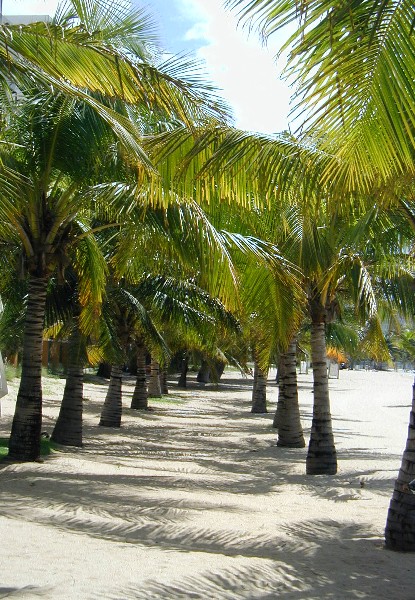
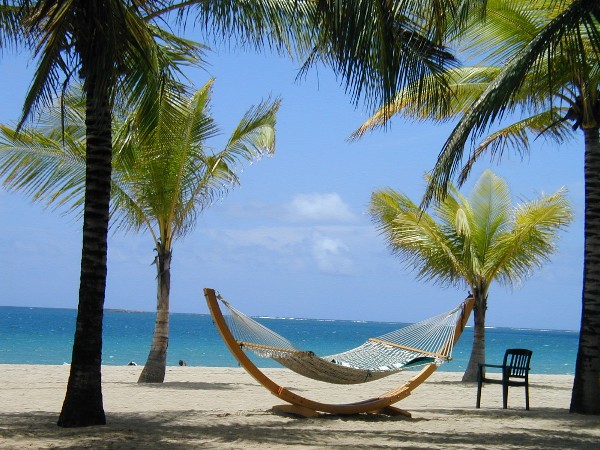
Every time I went somewhere - riding in a car or taxi or on the bus, or walking down the street - I saw wonderful plants. So I decided to spend some time on this last full day here in Puerto Rico just walking around and admiring plants. I strolled into fancy hotel forecourts, down little side streets, into car parks, and peered at gardens through the ubiquitous security grates. There were plants I recognized, others that might be familiar yet altered by the sub-tropical growing conditions, unknowns I managed to identify, and others that still baffle me. What fun I had!
Update: Jerry, bless his heart, checked with some of his friends who are expert in tropical flora. This is, indeed, a Mussaenda, many species of which are native to tropical Africa and Asia. Throwing caution to the wind, I'm going to speculate that this is some cultivar of M. erythrophylla, from tropical Africa. 'Queen Sirikit' is described as having drooping branches with broad wavy leaves, and - the clincher for me - flower heads of enlarged deep pink calyx lobes.
Before travelling to Puerto Rico I did some research, checking to see if any of the societies to which I belong have members there. Lo and behold, Garden Writers Association lists one member, Scott Appell, on Vieques, the "little sister" island southeast of San Juan. A telephone call, several e-mails, and arrangements were made for a visit. Now, as Scott advised me, getting there is not like taking the Staten Island ferry. There is a ferry, but it plies the waters of the Strait of Vieques on an infrequent schedule. While a boat ride (with the possibilitiy of seeing whales, dolphins, and manatees) would be delightful, since I was only making a day trip to Vieques travel time was a consideration. I decided to fly.
I've been on small airplanes before, the sort where every passenger gets a window seat, and every passenger has an aisle seat. The Cessna 402 operated by Cape Air that plies the skies between San Juan and Vieques is smaller yet.
Scott was waiting for me and off we went on a most delightful day filled with plants and gardens, casual and interesting conversations, delicious food, and an emerging friendship.
At five miles wide and 25 miles long Vieques nicely fits my preconceptions of "islands" as having modest size. Within that area it manages to fit beautiful beaches, attractive overlooks,
Scott's background (former director of the botanical garden on St. Croix) meant questions that kept bubbling up in my conversation, frequently "What's that plant?" - were readily answered, complete with background information and Latin names. We'd drive, stop, walk, talk, drive some more. I did find all the mangoes ripe enough to fall from the numerous trees and just rotting on the ground a source of great frustration. I love mangoes, and the hotel's breakfast buffet featured Red Delicious apples, watermelon, cantalope, and honeydew melons, when my mouth was set for mangoes, papayas, guavas, and such-like tropical fruits. I take that back. They did offer fresh pineapple. Papaya, once in the 8 days I had breakfast there. Did wangle a mangoe one evening at the manager's cocktail hour though.
All too soon it was time to leave. Even on Vieques one must check in early at the airport. No time to visit the magroves along the coast, and look for brown pelicans. Though I did see three kinds of hummingbirds, and the little yellow bird of song as we went around in and out of gardens. But there was one more stop to make, Scott assured me.
It rained in the morning, bucketing down hard enough to splash back up. Not a good day for outdoor activities. But by mid-day it had cleared to merely overcast and I decided to go as planned to the old city, Viejo San Juan. It was easy enough to walk from the hotel to the stop where I boarded the A5 bus. Fortunately I had the exact change for the 75¢ fare as that's what is required. With zigs and zags and stops to let passengers on and off we made our leisurely way to the terminus at Viejo San Juan where a free tourist trolley was waiting. Get on, get off, reboard - it makes it very easy to get around. Narrow streets and narrower sidewalks, numerous little shops with balconied apartments on the upper floors.
Wandering hither and thither on the charming little side streets I saw numerous cats asleep in doorways. Apparently the colonial cats of Viejo San Juan are included on the worldwide list of protected animal sanctuaries, joining the cats of Rome's coliseum and those at Hemingway House in Key West, Florida. Local cat rescue groups have an active trap / neuter / release program. More information can be found at Save A Cat.
In addition to the unanticipated cats and pigeons, I saw many plants - in little parks and plazas, growing in pots along the streets and up on the balconies. I especially enjoyed the plants at Casa Blanca, at the end of Calle San Sebastian.
East of Isla Verde is the community of Piñones. We drove there on Sunday morning, left the car in the parking lot at the western end of the boardwalk and went for a stroll.
We had decided that on Saturday we would drive to El Yunque, the grandfather mountain dressed in a tropical rain forest, the only one managed by the USDA Forest Service.
Now, "island" somehow implies a cozy size to me. Forget that. Much of Puerto Rico is terra incognito for me. My explorations were in San Juan, with two exceptions. Before setting off I had searched on the Internet for things horticultural to occupy my time while Paul was at work. Interestingly, there was mention of Festival de las Flores in the town of Aibonito. Held every year from the last weekend of June to the first weekend of July, this year it was pushed a week later. That meant I'd be in time to visit. But I'd need a car to get there. Paul caught a ride to work and left me the rental car's keys. A bright red little Hundyai Brio, it looked like something one should wind up, or maybe get out and push when going uphill. So that solved transportation. Navigation was the next consideration. Oh I had directions. But simultaneously driving and navigating was a little daunting. Not a problem. Jody, also visiting her husband, had one more day before returning home. What's more, she likes plants and gardens. With nice symmetry, her husband even gave Paul the necessary lift to work.
Jody and I navigated our way out of the hotel, avoided going to the airport, found the proper highways and worked our way up into the green mountains. Warmth and rain results in lush growth. I never knew there were so many kinds of palm trees. Puny plants grown as houseplants here at home exuberantly burst forth when - free at last from the confines of a flowerpot - they find themselves growing with their roots in the ground. Vining plants hurl themselves skyward, clutching trunks of towering trees for support. The ground is covered with dense mats of tradescantia (perhaps taxonomically re-ordered in setcresea, you know how quickly names change.) Bromeliads wedge themselves into forks of branches sizeable enough to be a tree were they growing anywhere else.
Following Jody's attention to directions, moderated by a modicum of "look at that!" and only one stop at a scenic pull-out we arrived at Aibonito. A modest $4 entry fee, and we strolled in to the 38th Festival de las Flores. Lots of booths selling heliconias and hedychiums, orchids and hibiscus and bougainvillea and bromeliads and nepenthes - and even a few marigolds and petunias too. But we were really there to see the exhibits.
All excellent outing for my first full day, and with a new-found friend to talk to, rehashing what we'd seen as we drove back to the hotel.
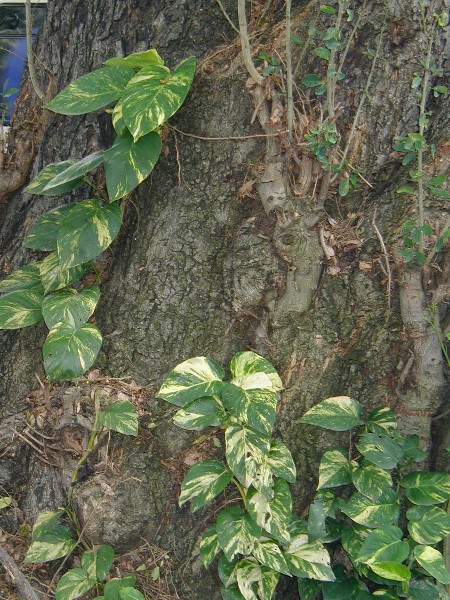
When these manage to vine their way up into more sunlight they seem to develop split leaves.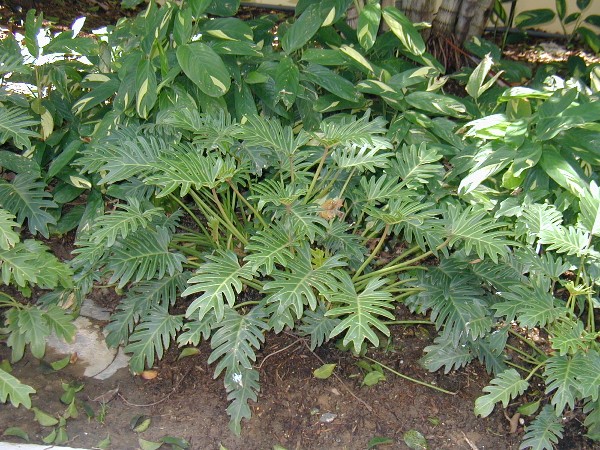
I think this is Philodendron 'Xanadu'.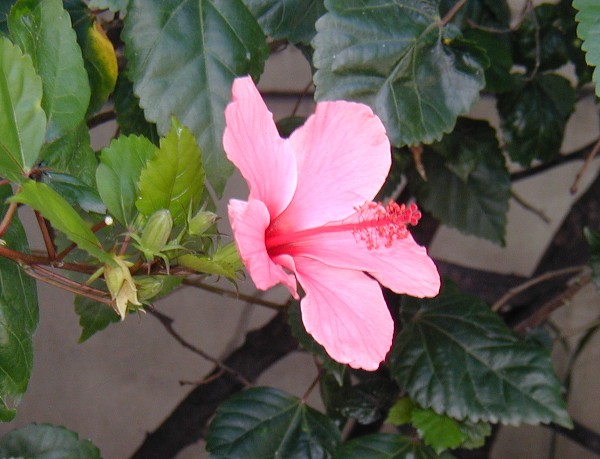
I thought this dainty pink one, embellished by its red stamens, was quite attractive.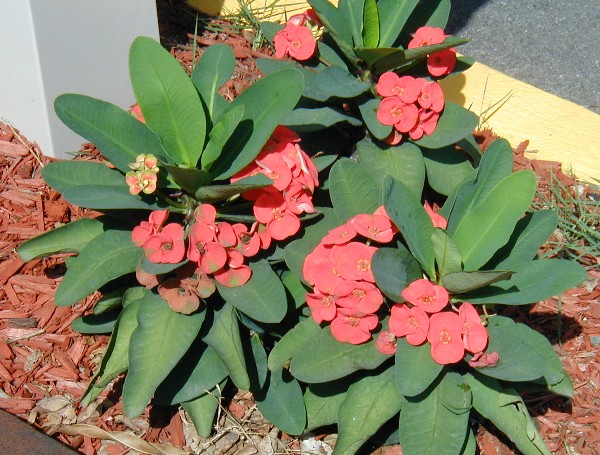
This large flowered cultivar will flower throughout the year here in the sub-tropics,
cycling into bloom with rain after a dry spell.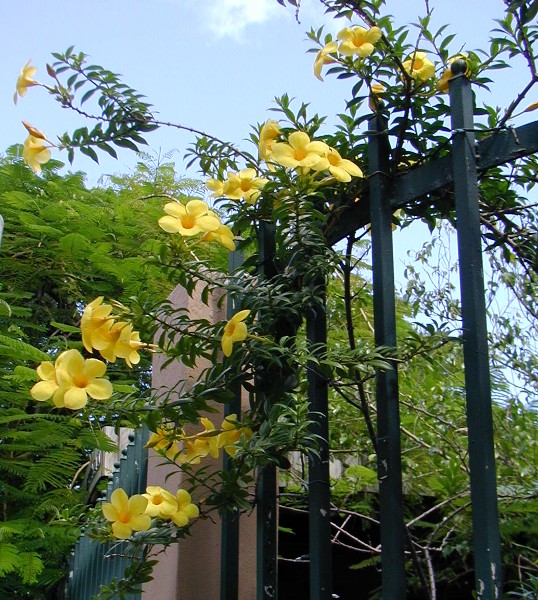
Attractive enough, but never as rambunctious as the strong, robust plants I saw in Puerto Rico.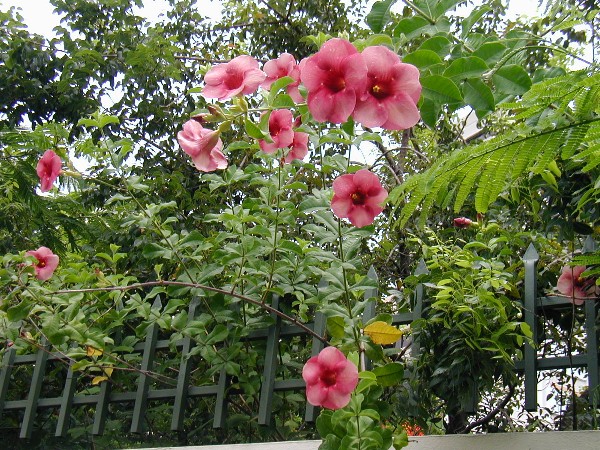
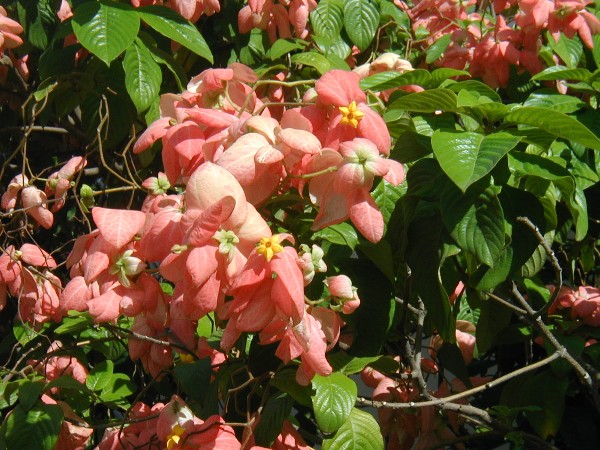
And the pink bits are bracts, similar to a poinsettia. Maybe it is a Mussaenda species, but I'm not sure.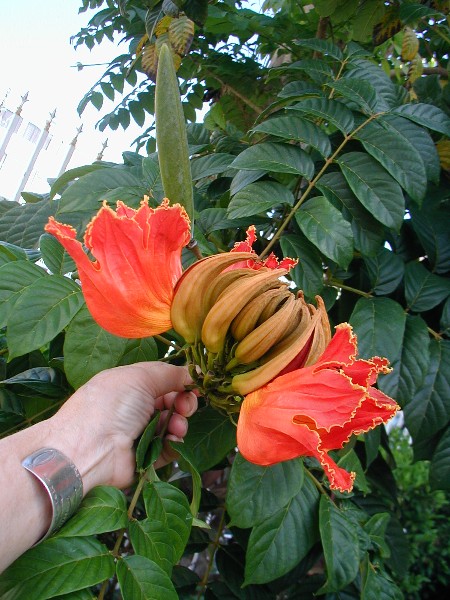
Robert Lee Riffle, author of The Tropical Look calls it "the world's most beautiful flowering tree." He gets no dissent from me.
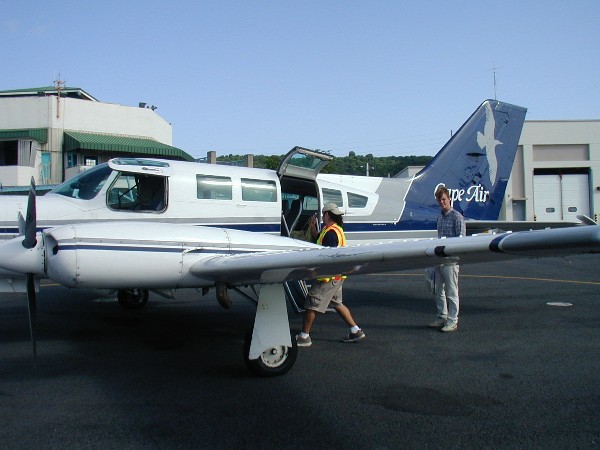
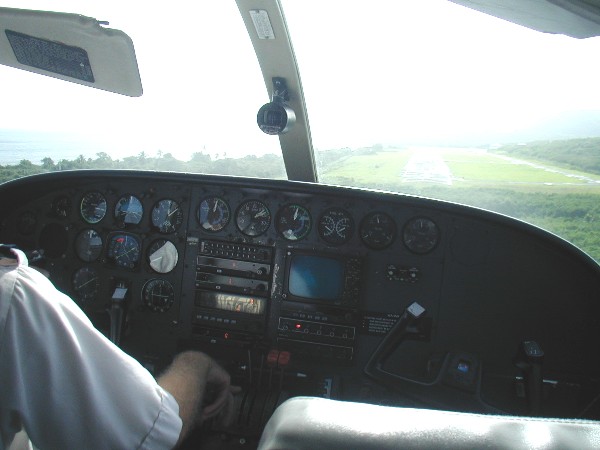

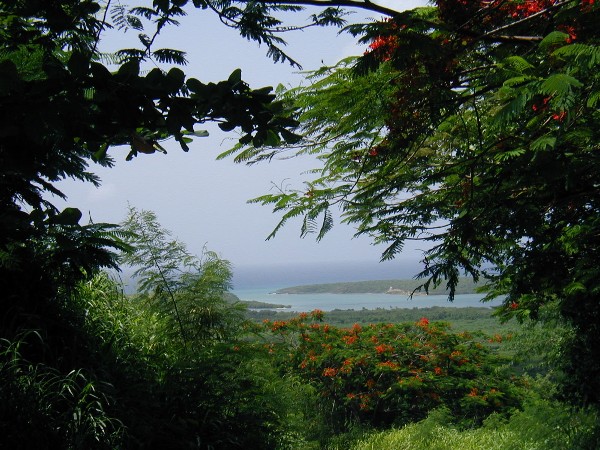
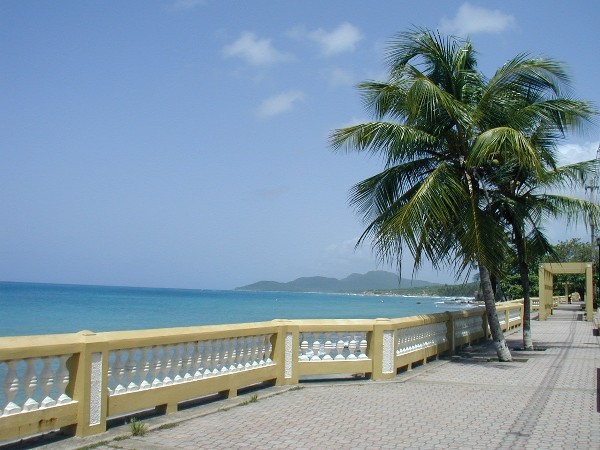
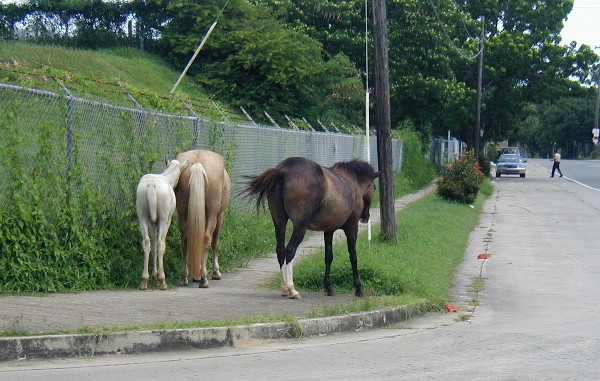
They can really do some damage, Scott told me, when they get into a garden.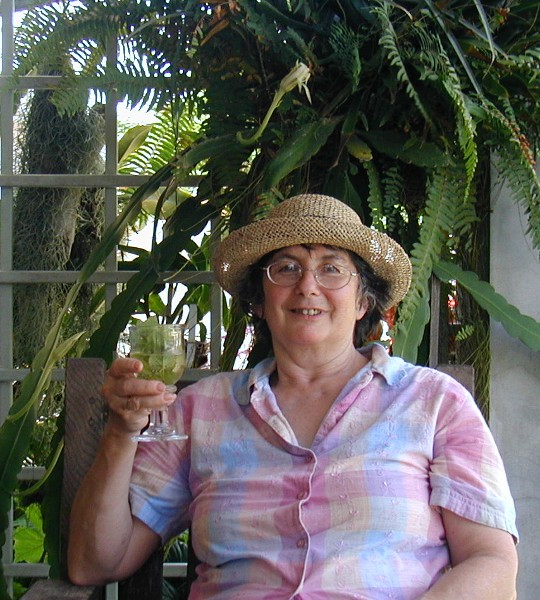
photo credit Bill Shank
Don't I look relaxed and cossetted though! 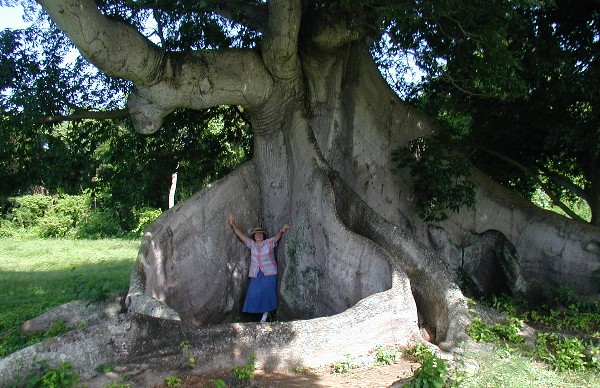
photo credit Scott Appell
Hundreds of years old, sacred to many of the island's religions.
Sheltered by its broad crown and butressing roots, I can but hope that it will bring me back to Vieques again.


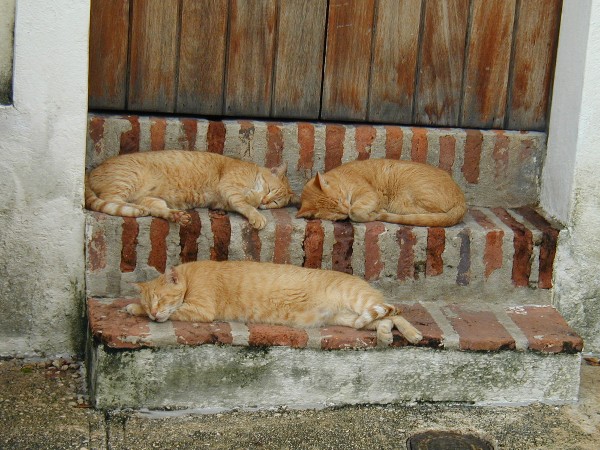
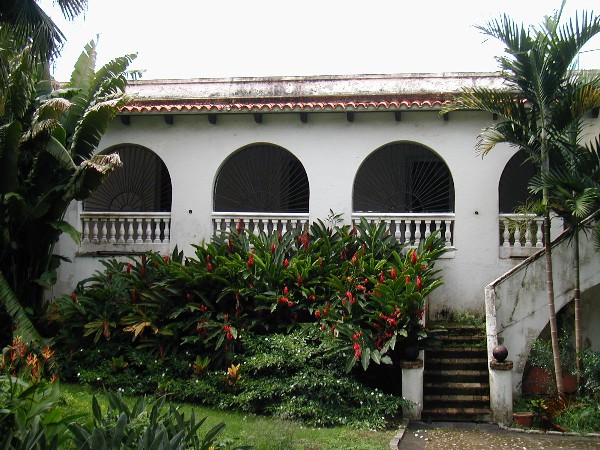
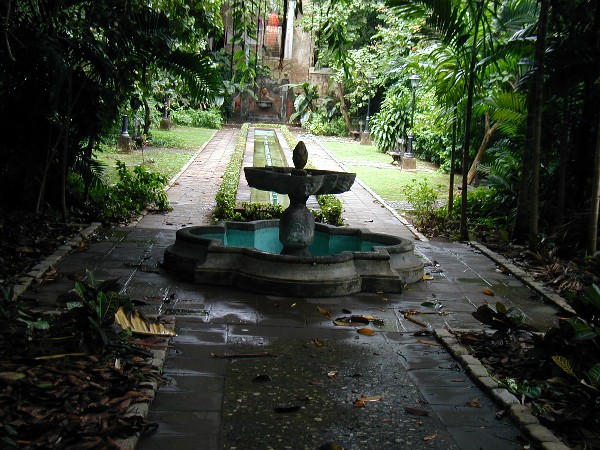
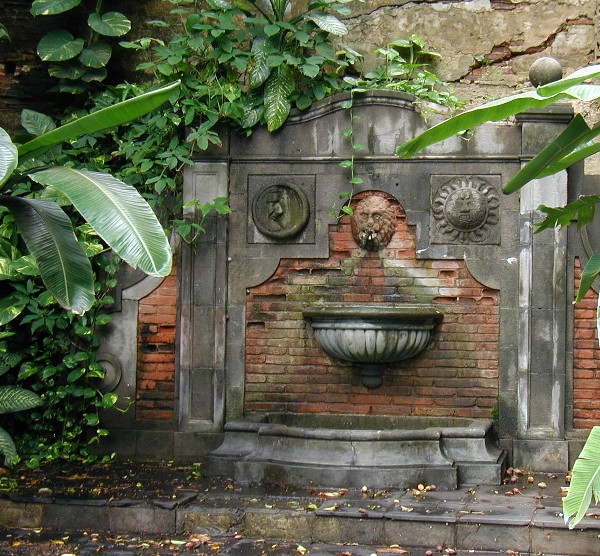
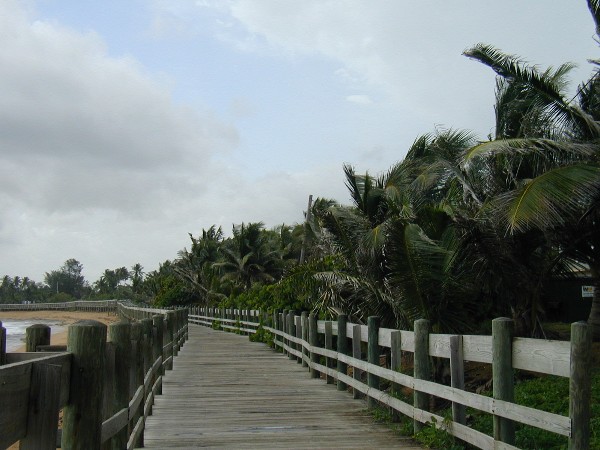
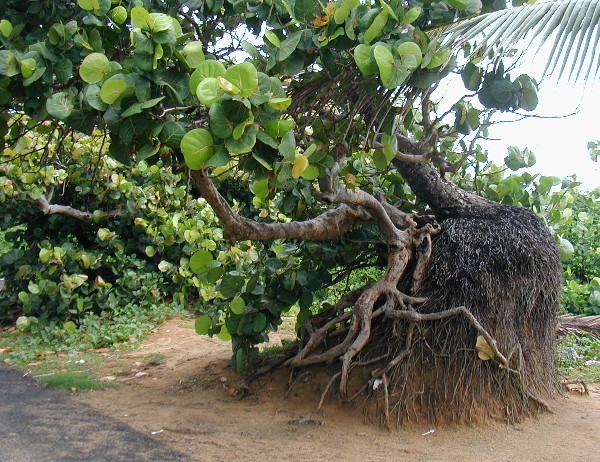
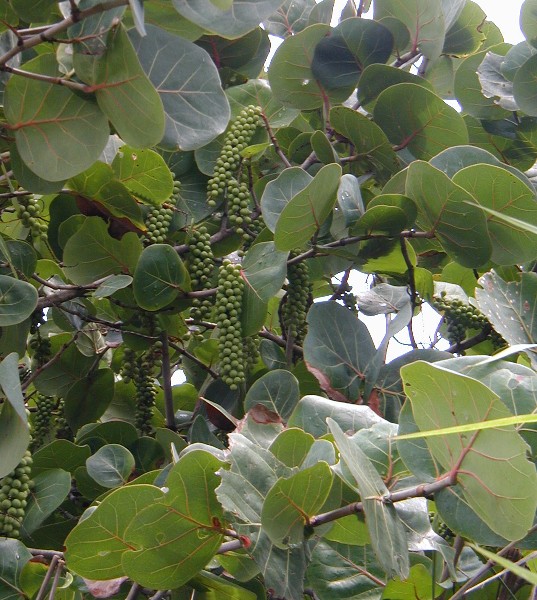
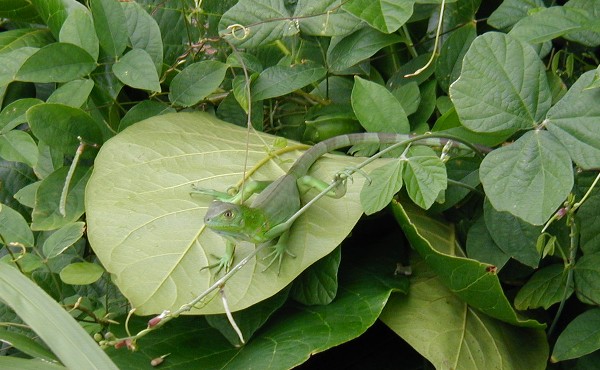
The iguanas, in turn, eat the fruits and disperse the sea grape's seeds.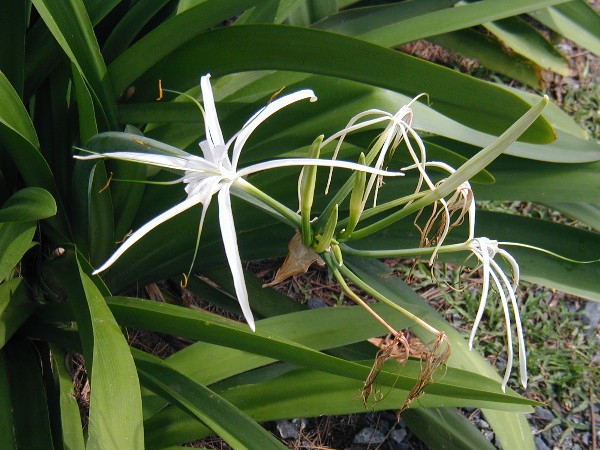
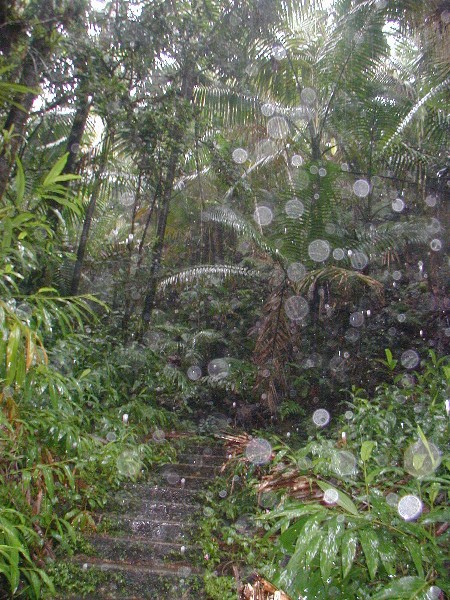


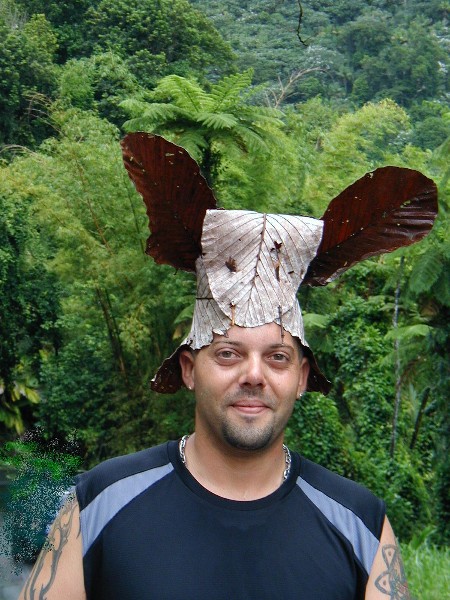
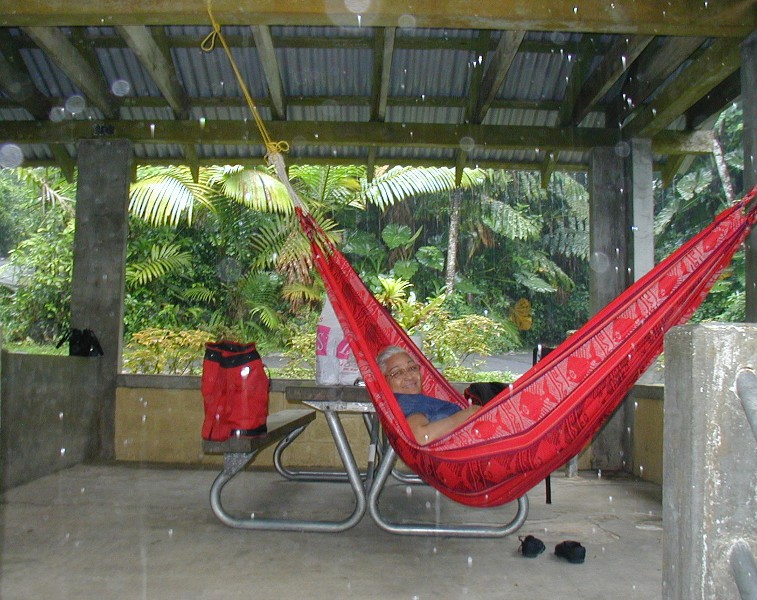
This grandmother is having a relaxing time in the hammock so thoughtful packed in along with the groceries.
A pleasant way to pass a rainy afternoon.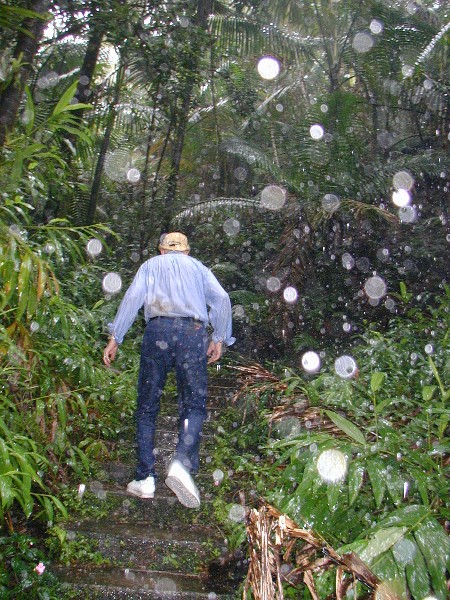
So it didn't matter to him that it was raining. He was already as wet as he could get.
![]()
This soft, peach-apricot heliconia with bold foliage is relatively subdued. 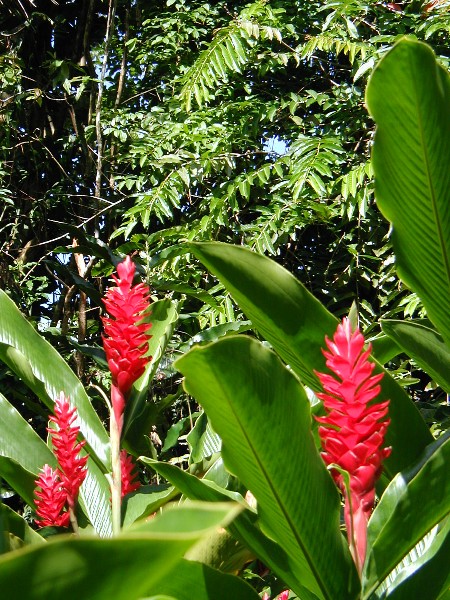
This vivid scarlet specimen adds a brilliant splash of color to the shady watercourse.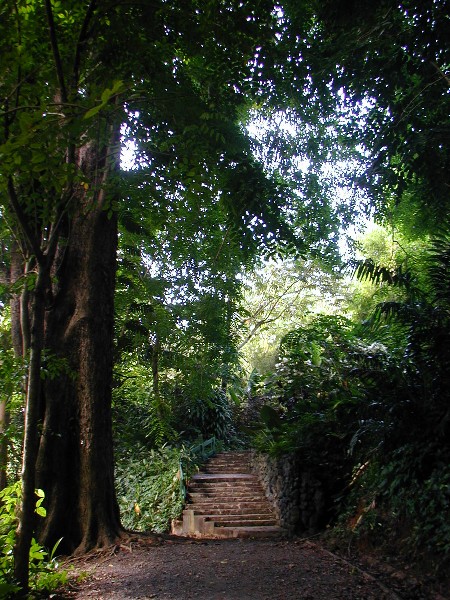
Shade is welcome in the day's heat.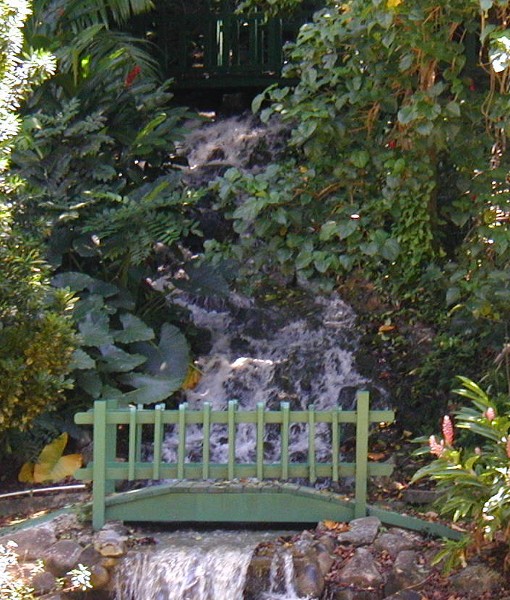
It also makes a pleasing focal point when viewed from the pond's other side.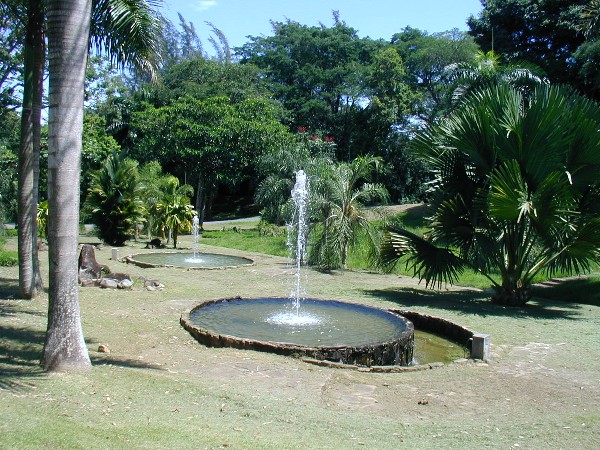
or, as here, wonderful fountains, exquisite in their simplicity.
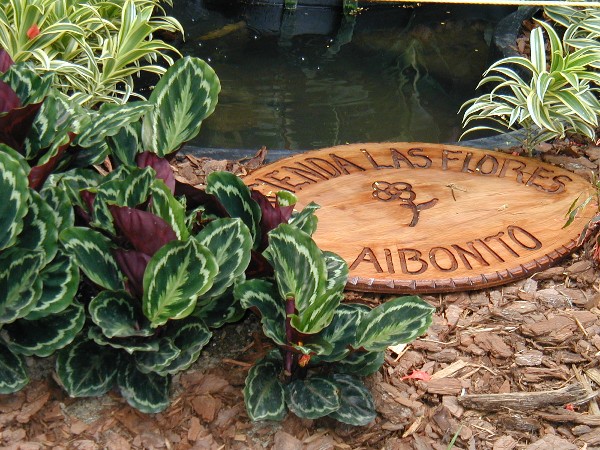
Foliage was often a major component of the exhibits. Many included a water feature. 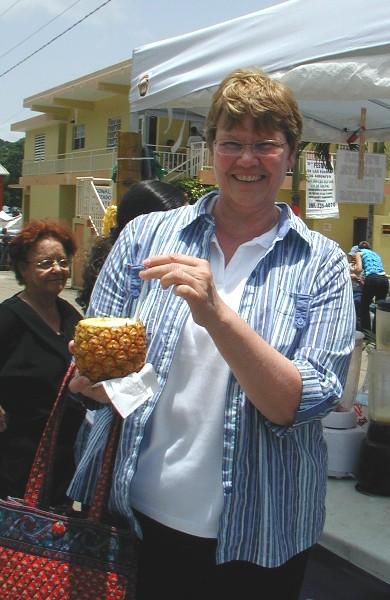
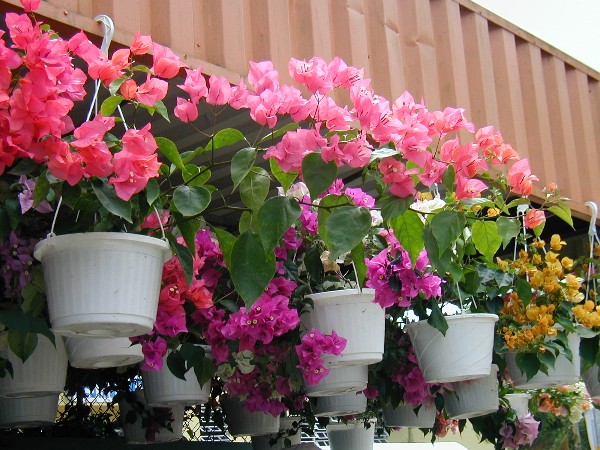
It was probably a first for both me and Jody, that we would come away without having bought some plants!